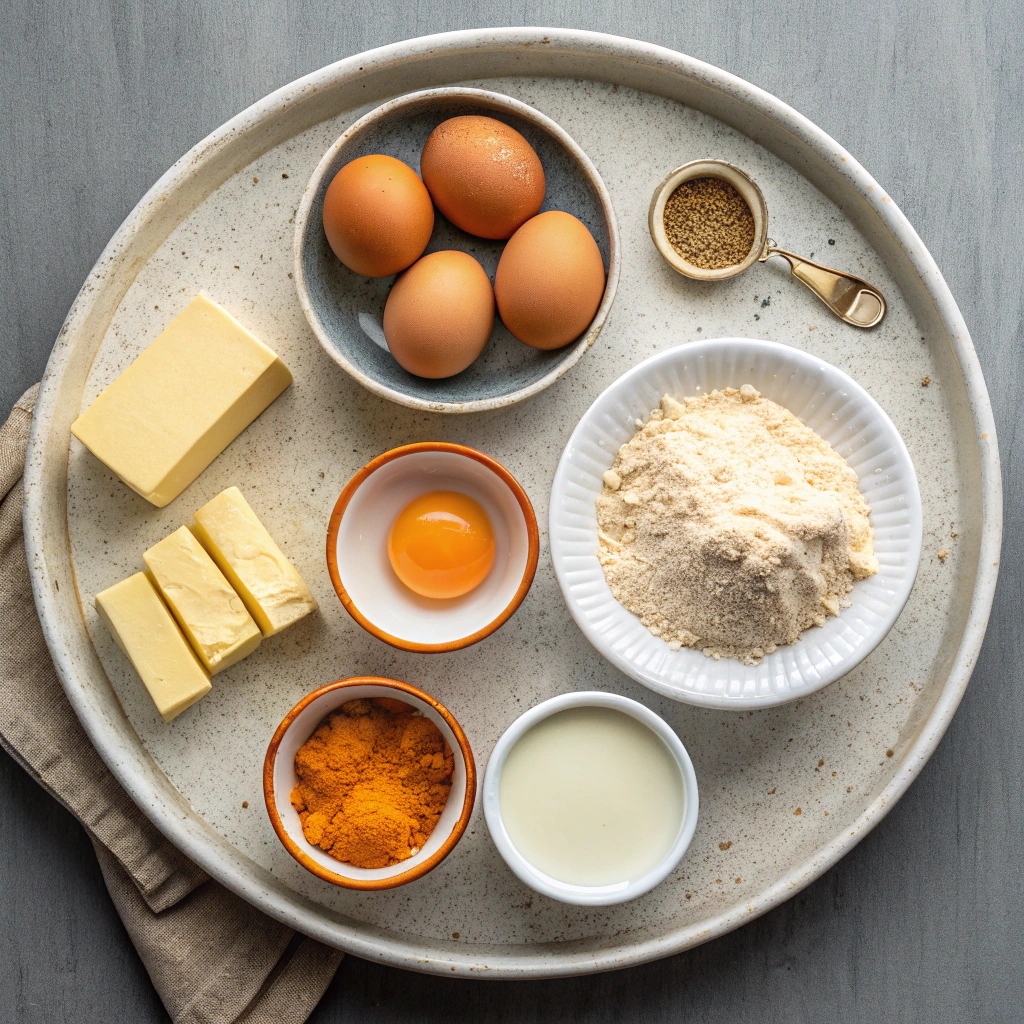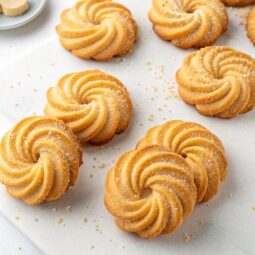These traditional Greek Easter cookies (Koulourakia) are a beloved holiday treat that brings Mediterranean warmth to any table.
Delicately twisted and beautifully golden-brown, these buttery delights strike the perfect balance between sweet and subtle.
In just over an hour, you’ll create 80 pieces of these authentic Greek cookies – perfect for sharing with family or storing for later enjoyment.
Each cookie is a manageable 88 calories, making them an ideal accompaniment to your afternoon coffee or tea.
The intro maintains an informative yet warm tone, highlighting key features (traditional, Greek, Easter) for SEO while engaging readers with sensory details and practical information.
It avoids the forbidden starting words and stays within the word limit while remaining inviting and descriptive.
Ingredients for Greek Easter Cookies (Koulourakia)

- Butter: 250g at room temperature for best results
- Sugar: 1 1/2 cups plain white sugar
- Baking Ammonia: 13g (or substitute with 2.5 tsp double acting baking powder)
- Milk: 1/2 cup lukewarm (130ml)
- Eggs: 4 medium eggs for dough, plus 2 yolks for glazing
- Vanilla Extract: 1 tablespoon
- Orange Zest: From 1 fresh orange
- All-purpose Flour: 1kg (35 oz)
- Glazing Mix: 2 egg yolks mixed with 1 tbsp water
Step-by-Step Instructions
- Cream the Base: Beat butter and sugar for 10-15 minutes until light and fluffy
- Prepare Leavening: Dissolve baking ammonia in warm milk, set aside
- Mix Wet Ingredients: Add eggs one at one, then vanilla, orange zest, and milk mixture
- Form Dough: Gradually add flour until you achieve a soft, manageable dough
- Rest Period: Cover dough with plastic wrap and let rest for 30 minutes
- Shape Cookies: Form dough into cords and shape into traditional designs
- Prepare for Baking: Arrange on parchment-lined trays, leaving space between each cookie
- Glaze and Bake: Brush with egg wash, bake at 200C/400F for 15-20 minutes until golden
- Cool and Store: Let cool completely on rack, then store in airtight containers
Shaping Tips & Techniques
Koulourakia can be shaped in many fun ways! The most common shapes are braided twists, rings, or the letter “S”. Try rolling the dough into ropes about 6-7 inches long and about the thickness of your pinky finger.
For braids, fold the rope in half and twist gently. For rings, simply connect the ends. Don’t worry if they’re not perfect – each cookie is meant to be unique and handmade with love!
Storage Tips
These Greek cookies are amazing because they stay fresh for so long! Keep them in an airtight container at room temperature for up to three weeks.
They’re perfect for making ahead of Easter celebrations. The cookies will actually get a bit crunchier over time, which many people love.
If you want to keep them longer, you can freeze them for up to 3 months – just make sure to thaw them completely before serving.
Serving Suggestions
Koulourakia are perfect dunking cookies! Pair them with your morning coffee or afternoon tea – the Greeks love them with their coffee.
They’re not too sweet, which makes them great for breakfast or as an afternoon snack. For Easter celebrations, arrange them on a pretty platter and dust with a little powdered sugar.
Kids love them plain, while grown-ups might enjoy them with a glass of sweet Vinsanto wine!
Recipe Tips & Substitutions
Can’t find baking ammonia? No problem! Use 2.5 teaspoons of double-acting baking powder instead. While traditional recipes use ammonia for that signature crunch, baking powder will still give you tasty results.
For the best texture, make sure your butter is truly at room temperature before starting. If you’re in a hurry, cut it into small cubes to speed up the softening.
Orange zest adds wonderful flavor, but lemon zest works great too. Just skip the citrus if you don’t have any – your cookies will still be yummy!

Koulourakia (Greek Easter Cookies)
Equipment
- Stand mixer
- baking trays
- Parchment Paper
Ingredients
Main Ingredients
- 250 g butter at room temperature (8.8 oz.)
- 1 1/2 cup plain white sugar
- 13 g powdered baking ammonia or 2.5 tsp double acting baking powder
- 1/2 cup lukewarm milk (130ml)
- 4 medium eggs
- 1 tbsp vanilla extract
- 1 orange zested
- 1 kg all-purpose flour (35 oz.)
For Glazing
- 2 egg yolks
- 1 tbsp water
Instructions
- To prepare this traditional koulourakia recipe, start by mixing the butter and sugar. In a mixer’s bowl add the sugar and butter (chopped) and mix for about 10-15 minutes, until the butter is creamy and fluffy. (Once starting to prepare this koulourakia recipe, make sure that the butter is at room temperature).
- In the meantime warm the milk until lukewarm and remove the pot from the heat. Add the ammonia and whisk until fully dissolved. Set aside.
- In the butter-sugar mixture, add the eggs one at a time, whilst mixing, allowing time for each one to be absorbed, before adding another. Pour in the the vanilla extract, the orange zest and the milk & ammonia blend and mix to combine. Add the flour, a little bit at a time, whilst mixing, until the ingredients are combined and the dough is soft and not too sticky.
- Cover the dough for the koulourakia with some plastic wrap and set aside to rest for 30 minutes.
- Place the dough for the koulourakia on a clean working surface, take a small piece of dough and form long cords. Shape the koulourakia with your hands, giving them any shape you like.
- Line a large baking tray with parchment paper and place the koulourakia, leaving some distance between them as they will rise a lot when baked. For this koulourakia recipe, you will need approx. 4-5 large baking trays, depending on the size of the cookies you make.
- In a small bowl add the egg yolks and 1 tbsp water and whisk with a fork. Brush the top of the koulourakia and bake in preheated oven at 200C/400F fan for 15-20 minutes, until fully cooked and golden brown on the outside (or the ammonia would not have been fully used up).
- Let the koulourakia cool down completely on a cooling rack and store in airtight containers for up to three weeks.
